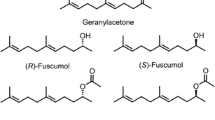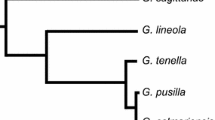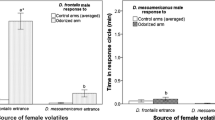Abstract
Insect predators can be guided to their prey by a kairomonal response to the prey pheromone. We found this phenomenon to be highly specific in the bark beetle predatorThanasimus dubius. Olfactory responses and behavioral tests revealed that the predator is guided to its major preyDendroctonusfrontalis by the primary enantiomer of the pheromone of the prey, (1S, 5R)-(−)-frontalin. These and other findings suggest the co-evolution of a kairomone system of the predator and the pheromone system of its prey.
Similar content being viewed by others
References
Bakke, A., andKvamme, T. 1981. Kairomone response inThanasimus predators to pheromone components ofIps typographies.J. Chem. Ecol. 7:305–312.
Borden, J.H., Handley, J.R., McLean, J.A., Silverstein, R.M., Chong, L., Slessor, K.M., Johnston, B.D., andSchuler, H.R. 1980. Enantiomer-based specificity in pheromone communication by two sympatricGnathotrichus species (Coleoptera: Scolytidae).J. Chem. Ecol. 6:445–446.
Coster, I.E., Payne, T.L., Hart, E.R., andEdson, L.J. 1977. Aggregation of the southern pine beetle in response to attractive host trees.Environ. Entomol. 6:725–731.
Dickens, J.C., andPayne, T.L. 1977. Bark beetle olfaction: Pheromone receptor system inDendroctonus frontalis.J. Insect Physiol. 23:481–489.
Dixon, W.N., andPayne, T.L. 1979. Aggregation ofThanasimus dubius on tress under mass attack by the southern pine beetle.Environ. Entomol. 8:178–181.
Fronk, W.D. 1947. The southern pine beetle—its life history.Va. Agric. Exp. Stn., Tech. Bull. 108:12 pp.
Futuyma, D.J. 1979. Evolutionary Biology, Sinauer and Associates, Sunderland, Massachusetts, pp. 459–462.
Hansen, K. 1983. Reception of bark beetle pheromone in the predaceous clerid beetle,Thanasimus formicarius (Coleoptera: Cleridae)J. Comp. Physiol 150:371–378.
Hopkins, A.D. 1899. Report on investigations to determine the cause of unhealthy conditions of the spruce and pine from 1880–1893.W. Va. Agric. Exp. Stn. Butt. 56. 461 pp.
Mizzell, R.F., andNebeker, T.E. 1982. Preference and oviposition rates of adultThanasimus dubius (F.) on three prey species.Environ. Entomol. 11:139–143.
Payne, T.L. 1975. Bark beetle olfaction. III. Antennal olfactory responsivenessof Dendroctonus frontalis Zimmerman andD. brevicomis Zimmerman LeConte (Coleoptera: Scolytidae) to aggregation pheromones and host tree terpene hydrocarbons.J. Chem. Ecol. 1:233–242.
Payne, T.L., Coster, J.E., Richerson, J.V., Hart, E.R., Hedden, R.L., andEdson, L.J. 1978. Reducing variation in field tests of behavioral chemicals for the southern pine beetle.J. Ga. Entomol. Soc. 13:85–90.
Payne, T.L., Richerson, J.V., Dickens, J.C., West, J.R., Mori, K., Berisford, C.W., Hedden, R.L., Vité, J.P., andBlum, M.S. 1982. Southern pine beetle: Olfactory receptor and behavior discrimination of enantiomers of the attractant pheromone frontalin.J. Chem. Ecol. 8:873–881.
Reeve, R.J., Coster, J.E., andJohnson, P.C. 1980. Spatial distribution of flying southern pine beetle (Coleoptera: Scolytidae) and the predatorThanasimus dubius (Coleoptera: Cleridae).Environ. Entomol. 9:113–118.
Rose, W.F., III, Billings, R.F., andVité, J.P. 1981. Southern pine bark beetles: Evaluation of non-sticky pheromone traps for survey and research.Southwest. Entomol. 6:1–9.
Schneider, D. 1957. Elektrophysiologische Untersuchungen von Chemo- und Mechano-rezeptoren der Antenne des SeidenspinnersBombyx mori L.Z. Vergl. Physiol. 40:8–41.
Silverstein, R.M. 1977. Complexity, diversity, and specificity of behavior-modifying chemicals: Examples mainly from Coleoptera and Hymenoptera, pp. 231–251,in H.H. Shorey and J.J. McKelvey, Jr. (eds.). Chemical Control of Insect Behavior: Theory and Application. John Wiley, New York.
Stewart, T.E., Plummer, E.L., McCandless, L., West, J.R., andSilverstein, R.M. 1977. Determination of enantiomer composition of several bicyclic ketal insect pheromone components.J. Chem. Ecol. 3:27–43.
Thatcher, R.C., andPickard, L.S. 1966. The clerid beetleThanasimus dubius, as a predator of the southern pine beetle.J. Econ. Entomol. 59:955–957.
Turnbow, R.H., Jr. 1979. An analysis of the impact of predation by adults of the clerid beetle,Thanasimus dubius (Fabricius). Dissertation, University of Georgia.
Vité, J.P., andCrozier, R.G. 1968. Studies on the attack behavior of the southern pine beetle IV. Influence of host condition on aggregation pattern.Contrib. Boyce Thompson Inst. 24:87–94.
Vité, J.P., andWilliamson, D.L. 1970.Thanasimus dubius: Prey perception.J. Insect Physiol. 16:233–239.
Vité, J.P., Ohloff, G., andBillings, R.F. 1978. Pheromonal chirality and integrity of aggregation response in southern species of the bark beetleIps species.Nature 272:817–818.
Wood, D.L., Browne, L.E., Bedard, W.D., Tilden, P.E., Silverstein, R.M., andRodin, J.O. 1968. Response ofIps confusus to the synthetic sex pheromone in nature.Science 159:1373–1374.
Wood, D.L., Browne, L.E., Ewing, B., Lindahl, K., Bedard, W.D., Tilden, P.E., Mori, K., Pitman, G.B., andHughes, P.R. 1976. Western pine beetle: Specificity among enantiomers of male and female components of an attractant pheromone.Science 192:896–898.
Author information
Authors and Affiliations
Additional information
Texas Agricultural Experiment Station paper No.TA17770. The work was funded in part by McIntire-Stennis project 1525 (TAES) and the USDA program entitled “The Expanded Southern Pine Beetle Research and Applications Program” through TAES-CSRS grant 680-15-10. The findings, opinions, and recommendations reported herein are those of the authors and not necessarily those of the United States Department of Agriculture.
Rights and permissions
About this article
Cite this article
Payne, T.L., Dickens, J.C. & Richerson, J.V. Insect predator-prey coevolution via enantiomeric specificity in a kairomone-pheromone system. J Chem Ecol 10, 487–492 (1984). https://doi.org/10.1007/BF00988094
Received:
Revised:
Issue Date:
DOI: https://doi.org/10.1007/BF00988094




